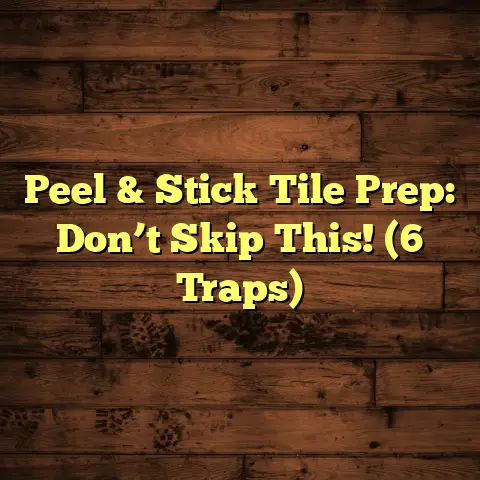Clean Motor Oil Off Garage Floor (9 Stain Removal Hacks)
Let’s be real, that sinking feeling when you spot a fresh motor oil stain on your garage floor?
I know it all too well.
It’s like a little piece of your pride gets chipped away.
Maybe it was a slightly overzealous oil change, a leaky classic car, or just the general wear and tear of DIY projects.
Whatever the cause, those ugly stains are a constant reminder of the mess, a potential slip hazard, and frankly, an eyesore that detracts from your awesome space.
I’ve seen it all, from pristine garages to those looking like an oil refinery exploded.
And I get it.
You want a clean, organized garage.
A place where you can tinker, create, and show off your prized possessions without cringing at the oil spots.
A clean garage isn’t just about aesthetics; it’s about reclaiming your space and feeling good about it.
I’m here to tell you those stains don’t have to be a permanent fixture.
Over the years, I’ve tried and tested countless methods, and I’m ready to share my top 9 stain removal hacks to get your garage floor looking like new again.
Let’s dive in!
Section 1: Understanding Motor Oil Stains
Before we get our hands dirty, let’s talk oil.
Motor oil isn’t just some simple liquid.
It’s a complex concoction of hydrocarbons, additives, and who-knows-what-else, all designed to keep your engine running smoothly.
But that complexity also makes it a pain to clean up.
Why is motor oil so tough to get rid of?
Well, concrete is porous.
Think of it like a sponge.
When oil spills, it seeps into those tiny pores, making it difficult to dislodge.
There are two main types of oil stains I encounter:
Fresh Stains: These are the easiest to tackle.
The oil is still on the surface and hasn’t had a chance to really soak in.Old Stains: These have been around for a while.
The oil has penetrated deeper, and the stain has likely oxidized, making it even more stubborn.
The type of stain dictates the approach.
And don’t forget the environment!
Temperature and humidity play a role.
Hot weather can make the oil more viscous and prone to soaking in faster, while damp conditions can affect the performance of some cleaning agents.
I’ve seen stains occur from all sorts of events:
-
DIY Car Maintenance: Drips and spills are almost inevitable when you’re under the hood.
-
Leaky Vehicles: That classic car might look cool, but it could be slowly staining your floor.
-
General Wear and Tear: Even just parking your car can leave small drips over time.
Understanding what you’re up against is half the battle!
Section 2: The Importance of Timely Action
Time is of the essence!
I can’t stress this enough.
The longer you let that oil sit, the harder it’s going to be to remove.
It’s like letting a wound fester – it just gets worse.
Why the urgency?
-
Permanent Damage: Oil can permanently discolor concrete, leaving a stain that no amount of scrubbing can erase.
-
Increased Difficulty: The longer the oil soaks in, the more deeply embedded it becomes, requiring more aggressive cleaning methods.
-
Safety Hazard: Oil stains can be slippery, increasing the risk of falls.
I remember one client who ignored a small oil stain for months.
By the time he called me, it had turned into a huge, dark blotch that required professional sandblasting to remove.
The cost and hassle could have been avoided with a quick cleanup!
According to the National Safety Council, falls are a leading cause of injury in the home.
A slippery oil stain only increases that risk.
Taking immediate action gives you the best chance of completely removing the stain and preventing long-term damage.
Plus, there’s a real satisfaction in tackling a mess head-on and seeing your garage floor looking fresh again!
Section 3: Hack #1 – Cat Litter Method
Alright, let’s get to our first hack!
This one’s a classic for a reason: cat litter.
Why cat litter?
It’s super absorbent.
It’s designed to soak up liquids, making it perfect for fresh oil spills.
Here’s how to use it:
-
Act Fast: The sooner you apply the litter, the better.
-
Cover Generously: Pour a thick layer of cat litter over the stain, making sure to completely cover it.
Crush It: Use your foot (with shoes on, of course!) or a heavy object to grind the litter into the stain.
This helps it absorb the oil more effectively.-
Wait Patiently: Let it sit for at least 24 hours, or even longer for larger spills.
-
Sweep It Up: Sweep up the used litter and dispose of it properly.
What kind of litter should you use?
I recommend clay-based litter.
It’s cheaper and more absorbent than the fancy stuff.
I’ve used this method countless times, and it’s surprisingly effective, especially on fresh spills.
It’s a simple, inexpensive way to soak up the oil before it has a chance to penetrate the concrete.
Section 4: Hack #2 – Baking Soda Power
Got an older, more stubborn stain? Baking soda might be your new best friend.
Baking soda is a mild alkali, which means it can help to break down the oil and lift it from the concrete pores.
Here’s the baking soda method:
-
Clean the Area: Remove any loose dirt or debris from the stain.
Make a Paste: Mix baking soda with water to create a thick paste.
The consistency should be similar to toothpaste.-
Apply the Paste: Spread the paste generously over the stain, making sure to cover it completely.
Let It Sit: Allow the paste to dry completely.
This could take several hours or even overnight.Scrub Vigorously: Use a stiff brush to scrub the area.
You might need to apply some elbow grease!-
Rinse Thoroughly: Rinse the area with water to remove any remaining baking soda residue.
I’ve found that adding a bit of dish soap to the paste can boost its cleaning power.
For really tough stains, you might need to repeat this process several times.
But trust me, it’s worth the effort!
Section 5: Hack #3 – Dish Soap and Hot Water
Sometimes, the simplest solutions are the most effective.
Dish soap and hot water are a surprisingly powerful combination for tackling oil stains.
Dish soap is designed to cut through grease and oil, making it a great option for cleaning up spills.
The hot water helps to loosen the oil and make it easier to remove.
Here’s the dish soap method:
-
Prepare the Solution: Mix a generous amount of dish soap with hot water in a bucket.
-
Apply the Solution: Pour the soapy water over the stain, making sure to saturate it completely.
Scrub, Scrub, Scrub: Use a stiff brush to scrub the area vigorously.
Focus on working the soap into the stain.Let It Sit: Allow the soapy water to sit on the stain for about 15-20 minutes.
This gives the soap time to break down the oil.-
Rinse Thoroughly: Rinse the area with clean water to remove any remaining soap and oil.
I recommend using a dish soap that’s specifically designed to cut through grease, like Dawn.
This method is particularly effective for fresh stains or stains that haven’t been allowed to set for too long.
Section 6: Hack #4 – Commercial Degreasers
When natural remedies don’t cut it, it’s time to bring out the big guns: commercial degreasers.
These products are specifically formulated to dissolve grease and oil, making them a powerful option for removing stubborn stains.
But with great power comes great responsibility.
You’ll need to be careful when using these products.
Here’s how to use commercial degreasers safely and effectively:
-
Choose the Right Product: Look for a degreaser that’s specifically designed for concrete floors.
-
Read the Instructions: Always read and follow the manufacturer’s instructions carefully.
-
Wear Protection: Wear gloves, eye protection, and a respirator to protect yourself from the chemicals.
-
Ventilate the Area: Open windows and doors to ensure proper ventilation.
-
Apply the Degreaser: Apply the degreaser to the stain, following the instructions on the product label.
-
Scrub the Area: Use a stiff brush to scrub the area.
-
Rinse Thoroughly: Rinse the area with clean water to remove any remaining degreaser and oil.
I’ve found that some degreasers can be quite harsh, so it’s always a good idea to test them on a small, inconspicuous area first to make sure they don’t damage the concrete.
Section 7: Hack #5 – Vinegar and Baking Soda Combo
Remember those science fair volcano projects?
Well, that same fizzing reaction can help lift oil stains!
The combination of vinegar and baking soda creates a chemical reaction that can help to break down the oil and lift it from the concrete pores.
Here’s how to use this dynamic duo:
-
Sprinkle Baking Soda: Generously sprinkle baking soda over the oil stain.
Pour on the Vinegar: Slowly pour vinegar onto the baking soda.
You’ll see it start to fizz!-
Let It Fizz: Allow the mixture to fizz for about 15-20 minutes.
-
Scrub the Area: Use a stiff brush to scrub the area.
-
Rinse Thoroughly: Rinse the area with clean water to remove any remaining residue.
The fizzing action helps to loosen the oil and lift it from the concrete.
I’ve had success with this method on both fresh and old stains, but it might require a few applications for really stubborn spots.
Section 8: Hack #6 – Absorbent Pads
For those prone to spills, or who want to be proactive, absorbent pads are a great investment.
These pads are specifically designed to soak up oil and other liquids.
They’re made from highly absorbent materials that can quickly and effectively remove spills.
Here’s how to use absorbent pads:
-
Place the Pad: Place the absorbent pad directly over the oil spill.
-
Let It Absorb: Allow the pad to sit on the spill until it’s completely saturated.
-
Dispose of Properly: Dispose of the used pad properly, following local regulations.
You can find absorbent pads at most auto parts stores or online retailers.
I recommend keeping a supply of these pads on hand in your garage.
They’re a quick and easy way to clean up spills before they have a chance to stain your floor.
Section 9: Hack #7 – Pressure Washing
For larger stains or heavily soiled floors, pressure washing can be a game-changer.
A pressure washer uses a high-pressure stream of water to blast away dirt, grime, and oil stains.
But be warned: pressure washing can be powerful, so you’ll need to take some precautions.
Here’s how to pressure wash your garage floor safely and effectively:
-
Clear the Area: Remove any loose objects or debris from the floor.
-
Wear Protection: Wear eye protection and closed-toe shoes.
-
Choose the Right Nozzle: Use a wide-angle nozzle to avoid damaging the concrete.
-
Test a Small Area: Test the pressure washer on a small, inconspicuous area first to make sure it doesn’t damage the concrete.
-
Apply the Water: Hold the nozzle about 12-18 inches from the floor and apply the water in a sweeping motion.
-
Rinse Thoroughly: Rinse the entire floor with clean water.
I recommend using a pressure washer with a pressure of at least 2000 PSI for best results.
You might also consider using a degreasing solution in conjunction with the pressure washer for extra cleaning power.
Section 10: Hack #8 – Sandblasting
Okay, we’re getting into the extreme measures now.
Sandblasting is a last resort for extremely stubborn stains that just won’t budge.
Sandblasting involves using a machine to blast abrasive materials, like sand, at the concrete surface.
This can effectively remove even the most deeply embedded stains.
But sandblasting is also a very aggressive method that can damage the concrete if not done properly.
When should you consider sandblasting?
-
Extremely Stubborn Stains: When all other methods have failed.
-
Deeply Embedded Stains: When the oil has penetrated deep into the concrete.
-
Damaged Concrete: When the concrete is already damaged and needs to be resurfaced.
I strongly recommend hiring a professional for sandblasting.
It’s a complex process that requires specialized equipment and expertise.
Section 11: Hack #9 – Sealing the Floor
Prevention is always better than cure!
Once you’ve got your garage floor looking pristine, the best way to keep it that way is to seal it.
A concrete sealant creates a protective barrier that prevents oil and other liquids from penetrating the concrete pores.
There are several types of sealants available, including:
-
Epoxy Sealants: These are durable and resistant to chemicals and abrasion.
-
Acrylic Sealants: These are less expensive than epoxy sealants, but they’re not as durable.
-
Polyurethane Sealants: These are flexible and resistant to UV damage.
I personally prefer epoxy sealants for garage floors.
They’re tough, long-lasting, and provide excellent protection against oil stains.
Sealing your garage floor is an investment that will save you time and effort in the long run.
It will also make your garage floor easier to clean and maintain.
Conclusion
You’ve made it to the end!
We’ve covered a lot of ground, from understanding motor oil stains to mastering 9 different stain removal hacks.
Remember that initial frustration of seeing those ugly oil stains?
Now imagine the satisfaction of seeing your garage floor clean, organized, and stain-free.
It’s not just about aesthetics.
It’s about reclaiming your space, taking pride in your garage, and creating a functional and enjoyable environment.
Don’t let those oil stains hold you back.
Choose the hack that’s right for you, roll up your sleeves, and get to work!
A clean garage is a happy garage.
And a happy garage leads to a happy you.
So go out there and transform your garage into a space you can be proud of!





